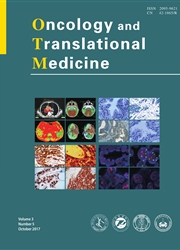

 中文摘要:
中文摘要:
探索 telomerase 活动的角色的目的为评估 laparoscopic 的功效在活体检视样品检测了在有肝细胞癌(HCC ) 和肝肝硬化的病人的射频脱离(RFA ) 治疗。从 2001 年 8 月的方法到 2004 年 10 月,有 HCC 的 34 个肝脏硬化症的病人被 laparoscopic RFA 在全身麻醉下面对待。34 个肿瘤的一个总数,与 4.0 ±的一条吝啬的最大的肿瘤直径 1.0 厘米,都位于肝表面或邻近胆囊。为肝损害的 Laparoscopic 指导超声的核心活体检视以前并且立即在 RFA 治疗以后被执行。在这些活体检视样品, telomerase 活动被基于 ELISA 的 telomeric 重复扩大协议(ELISA 陷井) 检测试金,和病理学的检查习惯性地被执行。结果 Laparoscopic RFA 成功地在所有 34 个病人被执行。完全的肿瘤坏死在在 laparoscopic RFA 以后扫描一个月的提高对比的螺旋状的 CT 上在所有病人被完成。在活体检视样品的 telomerase 活动和组织病理学说的诊断的积极的率是 91.2%(31/34 ) 并且 100%(34/34 ) 分别地在 RFA 前,并且 26.5%(9/34 ) 并且 0% 分别地在 RFA 以后。在 35 个月的一个中部的后续时期期间(范围, 18 51 个月),在在telomerase积极的 post-RFA 和否定病人的脱离地点的本地肿瘤复发的率是88.9%( 8/9 )并且4%( 1/25 )分别地( P 【 0.01 ),并且在肝以内的远复发的率是0%( 0/9 )并且12%( 3/25 )分别地( P 】 0.05 )。为有 HCC 的肝脏硬化症的病人的结论由 laparoscopic RFA 对待,在活体检视样品的 telomerase 活动的察觉可能为评估 RFA 的治疗效能并且预言手术后的本地肿瘤是有用的复发。
 英文摘要:
英文摘要:
Objective: To explore the role of telomerase activity detected in biopsy samples for evaluating the efficacy of laparoscopic radiofrequency ablation (RFA) therapy in patients with hepatocellular carcinoma (HCC) and liver cirrhosis. Methods: From August 2001 to October 2004, 34 cirrhotic patients with HCC were treated by laparoscopic RFA under general anesthesia. A total of 34 tumors, with a mean maximum tumor diameter of 4.0 + 1.0 cm, were all located on the liver surface or adjacent to the gallbladder. Laparoscopic ultrasound-guided core biopsy for liver lesions was performed before and immediately after RFA therapy. In these biopsy samples, telomerase activity was detected by the ELISA-based telomeric repeat amplification protocol (ELISA-TRAP) assay, and pathological examination was routinely performed. Results: Laparoscopic RFA was successfully performed in all the 34 patients. A complete tumor necrosis was achieved in all patients on the contrast-enhanced helical CT scanning one month after laparoscopic RFA. The positive rates of telomerase activity and histopathologic diagnosis in biopsy samples were 91.2% (31/34) and 100% (34/34) respectively before RFA, and 26.5% (9/34) and 0% respectively after RFA. During a median follow-up period of 35 months (range, 18-51 months), the rates of local tumor recurrence at the ablation sites in post-RFA telomerase-positive and negative patients were 88.9% (8/9) and 4% (1/25) respectively (P 〈 0.01), and the rates of distant recurrence within the livers were 0% (0/9) and 12% (3/25) respectively (P 〉 0.05). Conclusion: For cirrhotic patients with HCC treated by laparoscopic RFA, detection of telomerase activity in biopsy samples may be useful for evaluating the therapeutic efficacy of RFA and predicting postoperative local tumor recurrence.
 同期刊论文项目
同期刊论文项目
 同项目期刊论文
同项目期刊论文
 期刊信息
期刊信息
